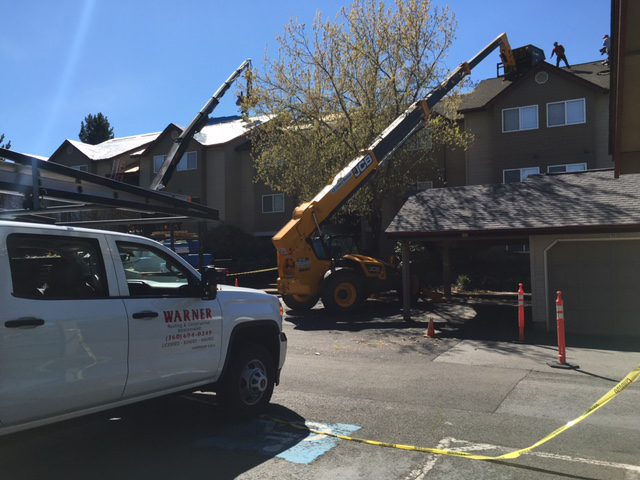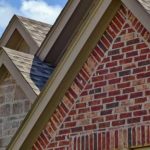As a homeowner, maintaining your roof is an important factor for the safety, functionality, and aesthetics of your home. Although most roofing materials will give you at least a solid 15-20 years, and some much longer, eventually a new roof will need to be considered. And what if you start noticing issues–will repairs take care of the problem? Knowing when to repair or replace a roof will go a long way to keep your home safe and secure and help retain its value.
Sometimes, the decision is made for you. If a huge storm causes wind damage–like uprooting a large tree and sending it into your home–you really don’t have a choice at that point. Or maybe you’re considering a whole-home remodel, and you decide metal roofing will look better than traditional asphalt shingles with the new aesthetic. In between those two situations, there are a lot of things to consider.
Repair or Replace Roof: What to Think About
Recently noticed a leak that could be coming from the roof, a slight dip in the roof, or maybe it just looks worn out? You’ll definitely want to have your roof inspected so you know what you’re dealing with. When it comes down to repairing or replacing a roof, here are a few factors to consider:
- Roof Age and Material
- Extent of Recent Damage
- Repair Frequency
- Visual Cues
- Curb Appeal
- Warranties
- Cost
Roof Age and Material
The age of your roof and the type of roofing materials used are critical factors in deciding whether to repair or replace. Most asphalt shingle roofs, for example, have a lifespan of about 20-25 years. Other materials like metal, tile, or slate can last significantly longer. If your roof is nearing the end of its expected lifespan, it might be more cost-effective in the long run to replace the roof rather than continue with repairs.
Different roofing materials have different durability and longevity. For instance, asphalt shingles are popular due to their affordability and ease of installation, but they don’t last as long as metal or slate roofs. Knowing the type of roof you have and its age will help you assess whether it’s time for a replacement or if repairs can extend its life.
The Extent of Recent Damage Plays a Part in Repairing or Replacing a Roof
 The extent of the damage plays a significant role in your decision to repair or replace your roof. Minor damage, such as a few missing shingles or small leaks, can often be repaired without the need for a full roof replacement. However, extensive damage from severe weather conditions can compromise the integrity of the roof deck and structure, requiring a full roof replacement.
The extent of the damage plays a significant role in your decision to repair or replace your roof. Minor damage, such as a few missing shingles or small leaks, can often be repaired without the need for a full roof replacement. However, extensive damage from severe weather conditions can compromise the integrity of the roof deck and structure, requiring a full roof replacement.
When assessing the extent of the damage, consider the overall condition of your roof. If the damage is localized and the rest of the roof is in good condition, repairing the affected area might be sufficient. On the other hand, widespread damage or multiple problem areas may indicate that replacing the roof is the more practical solution.
Repair Frequency
Frequent repairs are a clear sign that your roof may need to be replaced. If you find yourself regularly calling roofing companies for fixes, the cumulative cost of repairs might soon approach the cost of a new roof. Additionally, repeated repairs can be a sign that the roofing materials are deteriorating and can no longer provide adequate protection.
Consider the long-term implications of continuous repairs. While it might seem cost-effective in the short term to repair a roof, constantly addressing new issues can become a financial burden. At a certain point, investing in a new roof becomes the more cost-effective solution, providing peace of mind and reducing the need for frequent maintenance.
Visual Cues
Visual inspection can provide significant insights into whether you should repair or replace your roof. Look for signs such as curled, cracked, or missing shingles, which indicate that your roof is aging and may need replacement. Other indicators include sagging, moss or algae growth, and dark streaks.
Inspecting the roof deck is also important. If you notice any sagging areas, this could signify structural damage that necessitates a full roof replacement. Additionally, check your attic for signs of leaks, water damage, or light coming through the roof boards. These issues can indicate that your roof is no longer providing the necessary protection and may require replacement.
Curb Appeal
Your roof significantly contributes to the curb appeal of your home. If your roof looks old, worn out, or has mismatched patches from previous repairs, it can detract from the overall appearance of your property. Replacing the roof can enhance the aesthetic appeal of your home, making it more attractive to potential buyers if you decide to sell.
A new roof can dramatically improve the look of your home, giving it a fresh and well-maintained appearance. This is particularly important if you’re planning to sell your house soon. A visually appealing roof can increase the home’s value and curb appeal, making it more appealing to buyers.
Warranties
Warranties are another critical factor to consider when deciding whether to repair or replace your roof. New roofs often come with warranties that cover materials and workmanship, providing peace of mind and financial protection. If your current roof is still under warranty, repairs might be covered, saving you money.
However, if your roof’s warranty is nearing expiration or has already expired, investing in a new roof with a fresh warranty can be beneficial. This new warranty will cover future repairs and give you confidence that your investment is protected. Discussing warranty options with a roofing contractor can help you understand the benefits of a new roof versus continued repairs.
Repair or Replace Roof: Cost
Cost is often the deciding factor for many homeowners when it comes to roof repairs or replacements, but shouldn’t be the only factor. While replacing a roof is a significant upfront investment, it can be more cost-effective in the long run. Consider the cost of frequent repairs and potential damage to your home’s interior if the roof fails.
A new roof can also improve your home’s energy efficiency, leading to lower heating and cooling costs. Energy-efficient roofing materials can reflect more sunlight and absorb less heat, reducing the strain on your HVAC system. Over time, these savings can offset the initial cost of replacing the roof.
FAQs

How often should I inspect my roof?
You should inspect your roof at least twice a year, preferably in the spring and fall. Additionally, inspect your roof after major storms or severe weather events to identify and address any damage promptly. Regular inspections can help catch minor issues before they escalate into major problems, extending the life of your roof.
What are the signs that my roof needs immediate attention?
Immediate signs that your roof needs attention include visible leaks, missing or damaged shingles, sagging areas, and water stains on your ceiling or walls. If you notice any of these issues, contact a roofing contractor immediately to prevent further damage. Other signs include excessive granules in your gutters, which indicate shingle wear, and light shining through the roof boards in your attic.
Can minor leaks be repaired without replacing the roof?
Yes, minor leaks can often be repaired without the need for a full roof replacement. A professional roofing contractor can identify the source of the leak and make the necessary repairs to stop water infiltration. However, if leaks are widespread or recurring, it might indicate a more significant issue that requires a full roof replacement.
Is re-roofing an option?
Re-roofing, or overlaying a new layer of shingles over the existing ones, can be an option if your roof is in good condition and has only one layer of shingles. This method can be more cost-effective and quicker than a full replacement. However, re-roofing is not always recommended, especially if there are underlying issues with the roof deck or multiple layers of shingles already in place.
Should I consider a new roof during a whole-home remodel even if it’s in good shape?
If you’re undertaking a whole-home remodel, it might be worth considering a new roof, even if your current one is in good shape. A new roof can enhance the overall aesthetics and value of your home, especially if you’re updating other exterior elements. Additionally, coordinating the roof replacement with other remodeling projects can save time and minimize disruptions.
When to Repair or Replace Roof: Professional Installation Matters
Whether you decide to repair or replace your roof, it’s crucial to hire an experienced roofing contractor like Warner Roofing and Construction. Professional installation ensures that the job is done correctly, providing long-term protection for your home. A new roof is only as good as its installation, and poor workmanship can lead to premature failures and additional costs.
At Warner Roofing and Construction, we pride ourselves on delivering high-quality roofing projects tailored to your specific needs. Our team of experts will assess the extent of the damage, recommend solutions, and ensure that your roof is installed to the highest standards. Contact us today to schedule a consultation and protect your home with a durable, expertly installed roof or high-quality repair.







